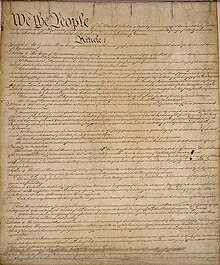In ancient manuscripts, another means to divide sentences into paragraphs was a line break (newline) fol
History[edit]
The oldest classical Greek and Latin writing had little or no space between words and could be written in boustrophedon (alternating directions). Over time, text direction (left to right) became standardized, and word dividers and terminal punctuation became common. The first way to divide sentences into groups was the original paragraphos, similar to an underscore at the beginning of the new group.[3] The Greek paragraphos evolved into the pilcrow (¶), which in English manuscripts in the Middle Ages can be seen inserted inline between sentences. The hedera leaf (e.g. ☙) has also been used in the same way.
In ancient manuscripts, another means to divide sentences into paragraphs was a line break (newline) followed by an initial at the beginning of the next paragraph. An initial is an oversized capital letter, sometimes outdented beyond the margin of the text. This style can be seen, for example, in the original Old English manuscript of Beowulf. Outdenting is still used in English typography, though not commonly.[4] Modern English typography usually indicates a new paragraph by indenting the first line. This style can be seen in the (handwritten) United States Constitution from 1787. For additional ornamentation, a hedera leaf or other symbol can be added to the inter-paragraph whitespace, or put in the indentation space.
A second common modern English style is to use no indenting, but add vertical white space to create "block paragraphs." On a typewriter, a double carriage returnproduces a blank line for this purpose; professional typesetters (or word processing software) may put in an arbitrary vertical space by adjusting leading. This style is very common in electronic formats, such as on the World Wide Web and email.
Typographical considerations[edit]
In computing[edit]
In word processing and desktop publishing, a hard return or paragraph break indicates a new paragraph, to be distinguished from the soft return at the end of a line internal to a paragraph. This distinction allows word wrap to automatically re-flow text as it is edited, without losing paragraph breaks. The software may apply vertical whitespace or indenting at paragraph breaks, depending on the selected style.
How such documents are actually stored depends on the file format. For example, HTML uses the <p> tag as a paragraph container. In plaintext files, there are two common formats. Pre-formatted text will have a newline at the end of every physical line, and two newlines at the end of a paragraph, creating a blank line. An alternative is to only put newlines at the end of each paragraph, and leave word wrapping up to the application that displays or processes the text.
A line break that is inserted manually, and preserved when re-flowing, may still be distinct from a paragraph break, although this is typically not done in prose. HTML's <br /> tag produces a line break without ending the paragraph; the W3C recommends using it only to separate lines of verse (where each "paragraph" is a stanza), or in a street address.[7]
Numbering[edit]
Paragraphs are commonly numbered using the decimal system, where (in books) the integral part of the decimal represents the number of the chapter and the fractional parts are arranged in each chapter in order of magnitude. Thus in Whittaker and Watson's 1921 A Course of Modern Analysis, chapter 9 is devoted to Fourier Series; within that chapter §9.6 introduces Riemann's theory, the following section §9.61 treats an associated function, following §9.62 some properties of that function, following §9.621 a related lemma, while §9.63 introduces Riemann's main theorem, and so on. Whittaker and Watson attribute this system of numbering to Giuseppe Peano on their "Contents" page, although this attribution does not seem to be widely credited elsewhere.[8]
Section breaks[edit]
Many published books use a device to separate certain paragraphs further when there is a change of scene or time. This extra space, especially when co-occurring at a page or section break, may contain an asterisk, three asterisks, a special stylistic dingbat, or a special symbol known as an asterism.
Purpose and style advice[edit]
A common English usage misconception is that a paragraph has three to five sentences; single-word paragraphs can be seen in some professional writing, and journalists often use single-sentence paragraphs.[9]
The crafting of clear, coherent paragraphs is the subject of considerable stylistic debate. Forms generally vary among types of writing. For example, newspapers, scientific journals, and fictional essays have somewhat different conventions for the placement of paragraph breaks.
English students are sometimes taught that a paragraph should have a topic sentence or "main idea", preferably first, and multiple "supporting" or "detail" sentences which explain or supply evidence. One technique of this type, intended for essay writing, is known as the Schaffer paragraph. For example, the following excerpt from Dr. Samuel Johnson's Lives of the English Poets, the first sentence is the main idea: that Joseph Addison is a skilled "describer of life and manners". The succeeding sentences are details that support and explain the main idea in a specific way.
This advice differs from stock advice for the construction of paragraphs in Japanese (translated as danraku 段落).[10]

Comments
Post a Comment